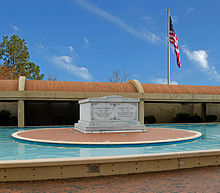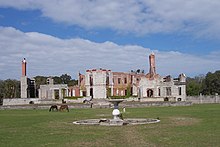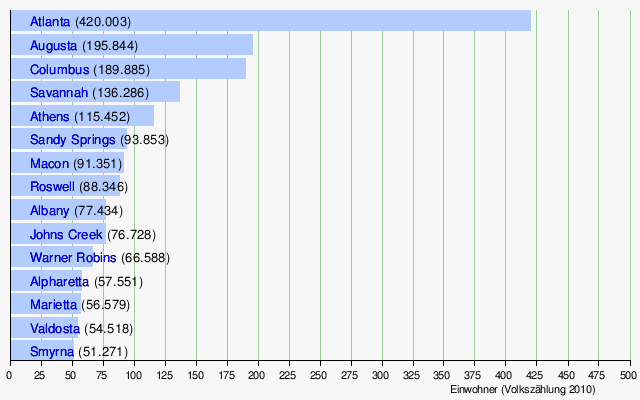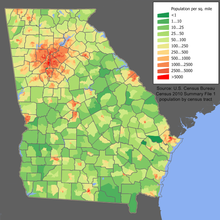Georgia (U.S. state)
![]()
The title of this article is ambiguous. For other meanings, see Georgia (disambiguation).
Georgia (English pronunciation [![]()
![]() ˈdʒɔɹdʒə]), officially English State of Georgia, is a state in the southeastern United States of America (USA). Georgia was founded in 1732 as the last of the Thirteen Colonies, and became the fourth state to ratify the United States Constitution on January 2, 1788. It seceded from the United States on January 19, 1861, and was one of the eleven Confederate States of America until 1865. Georgia was named after George II. The nickname is Peach State.
ˈdʒɔɹdʒə]), officially English State of Georgia, is a state in the southeastern United States of America (USA). Georgia was founded in 1732 as the last of the Thirteen Colonies, and became the fourth state to ratify the United States Constitution on January 2, 1788. It seceded from the United States on January 19, 1861, and was one of the eleven Confederate States of America until 1865. Georgia was named after George II. The nickname is Peach State.
Geography
Geographical position
The north of the state is located in the Blue Ridge Mountains. The highest point of the state is the Brasstown Bald (1458 m). The length of the coast on the Atlantic Ocean is 161 km.
Extension of the national territory
Georgia has a longitude of 370 km in the west-east direction between 81°W to 85°53'W and a latitude of 480 km in the north-south direction between 30°31'N to 35°N.
Neighbouring countries
Georgia borders the Atlantic Ocean to the east, the state of South Carolina to the northeast, the states of North Carolina and Tennessee to the north, the state of Alabama to the west, and the state of Florida to the south.
The border with South Carolina is formed, starting at the Atlantic Ocean, by the Savannah River - up to the point where the Tugaloo River and Seneca River join to form the Savannah River. West of this, the Tugaloo forms the boundary between Georgia and South Carolina. The Chattooga River, a tributary of the Tugaloo, forms the further border with South Carolina. The Savannah River is dammed at several reservoirs, particularly in its upper reaches. Originally, the river's valley path formed the border between Georgia and South Carolina, but due to the damming of the lakes, this is no longer recognizable in many places. The border with South Carolina is the only Georgia border formed solely by bodies of water, and was established in 1797 in the Treaty of Beaufort.
In the northeasternmost county, Rabun County, the border with North Carolina begins, running strictly westward from there along the 35th parallel. This northern border of the state of Georgia is formed approximately half by the border with North Carolina, the other half by that with Tennessee, which was a territory of North Carolina until independence. To the northwest, Georgia borders directly on Chattanooga. A little farther west the border makes a sharp turn to the south. To the west of the border is Alabama. In the northern half the boundary runs in a straight line south-southeastward until it reaches the Chattahoochee River at West Point, which henceforth forms the boundary in the southern half. This is also the boundary between two time zones: Georgia is on Eastern Time, Alabama is on Central Time.
The southern boundary with Florida extends eastward from the confluence of the Flint River and Chattahoochee River (which continues southward on the Florida side as the Apalachicola River). At first the border is straight, in the east it follows the course of the St. Mary's River into the Atlantic Ocean.
Structure
Georgia is divided into 159 counties. Thus, Georgia is the state with the second highest number of counties after Texas with 254 counties.
→ Main article: List of counties in Georgia
Natural monuments
The National Park Service designates Georgia as having one National Scenic Trail, one National Historic Trail, one National Recreation Area, one National Seashore, and three National Heritage Areas:
- Appalachian Trail
- Trail of Tears
- Chattahoochee River National Recreation Area
- Cumberland Island National Seashore
- Arabia Mountain National Heritage Area
- Augusta Canal National Heritage Area
- Gullah/Geechee Cultural Heritage Corridor
In addition, there are eleven National Natural Landmarks (as of September 30, 2017).
Cultural monuments
Georgia is home to three National Monuments, one National Military Park, one National Battlefield Park, two National Historic Sites, and one National Historical Park:
- Fort Frederica
- Fort Pulaski
- Ocmulgee
- Chickamauga and Chattanooga National Military Park
- Kennesaw Mountain National Battlefield Park
- Andersonville National Historic Site
- Jimmy Carter National Historic Site
- Martin Luther King Jr. National Historical Park
In addition, there are 49 National Historic Landmarks and 2141 structures and sites listed on the National Register of Historic Places (as of September 30, 2017).

Gravesite of Martin Luther King and Coretta Scott King at Martin Luther King Jr. National Historical Park (2012)

The ruins of Dungeness in the Cumberland Island National Seashore (2005)
Population
Georgia has a population of 9,687,653 as of 2010, of which 55.9% are white, 30.5% are African American, 8.8% are Hispanic or Latino, 3.2% are Asian American, and 0.3% are Native American. Georgia ranks 9th among the states by population. There are 3,540,690 households in existence.
Religions
The major religious denominations in 2000 were the Southern Baptist Convention with 1,719,484 members, the United Methodist Church with 570,674 persons, and the Catholic Church with 374,185 members.
There are many other denominations, mainly Protestant.
Largest cities
Georgia cities with populations of 50,000 or more, according to the 2010 Census:

- List of places in Georgia
| Population development | |||
| Census | Inhabitants | ± in % | |
| 1790 | 82.548 | - — | |
| 1800 | 162.686 | 97,1 % | |
| 1810 | 251.407 | 54,5 % | |
| 1820 | 340.989 | 35,6 % | |
| 1830 | 516.823 | 51,6 % | |
| 1840 | 691.392 | 33,8 % | |
| 1850 | 906.185 | 31,1 % | |
| 1860 | 1.057.286 | 16,7 % | |
| 1870 | 1.184.109 | 12 % | |
| 1880 | 1.542.181 | 30,2 % | |
| 1890 | 1.837.353 | 19,1 % | |
| 1900 | 2.216.331 | 20,6 % | |
| 1910 | 2.609.121 | 17,7 % | |
| 1920 | 2.895.832 | 11 % | |
| 1930 | 2.908.506 | 0,4 % | |
| 1940 | 3.123.723 | 7,4 % | |
| 1950 | 3.444.578 | 10,3 % | |
| 1960 | 3.943.116 | 14,5 % | |
| 1970 | 4.589.575 | 16,4 % | |
| 1980 | 5.463.105 | 19 % | |
| 1990 | 6.478.216 | 18,6 % | |
| 2000 | 8.186.453 | 26,4 % | |
| 2010 | 9.687.653 | 18,3 % | |
| Before 1900 1900–1990 2000 2010 | |||

Population density
Search within the encyclopedia